I say Rio and you think beach, half naked women (at least I do!), the
statue of the Christ, Copacabana, beach football, carnival, endless parties and
favelas. And you would be right. Rio is nicknamed "Cidade Maravilhosa" (Marvelous City) and it is well deserved.
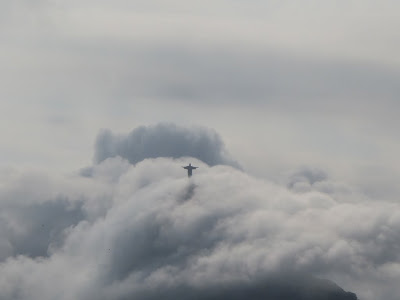 |
| The Christ emerging from the clouds - very symbolic |
You might not think of rain though but when we
arrived in Rio it was pouring and you know how it is in big busy cities with
warm climates when it rains: it's hell. There are puddles, more traffic jams and generally
more commotion. We managed to get to our
hostel which was at the end of Copacabana beach (yippie!) but just at the
entrance of a Favela (oh oh!). But they say it is a "pacified" favela
which makes it safer... at least that's the theory.
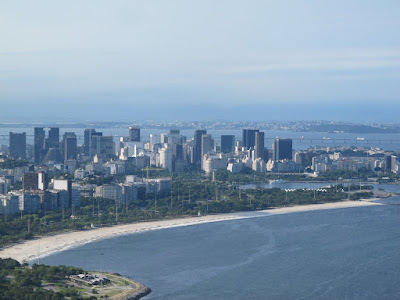 |
| Astounding views of one of Rio's bays from the Sugar Loaf |
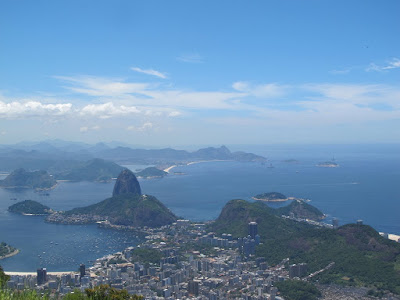 |
| And the Sugar Loaf taken from the Christ Redeemer |
At first glance it looked good, there was a police car at the entrance,
and another one 400 metres up the very steep hill. Right opposite our hostel
was a community centre and the police, we were told, stay there 24/7. The
hostel looked very nice (Lisetonga Hostel), nice open space, friendly staff,
good size TV room, clean kitchen and bathrooms and a central patio where
breakfast is served weather permitting. It used to be a mansion but with the
expansion of favelas in the 50's and 60's many of the wealthy people living in
such mansions moved somewhere else. We were supposed to move to another hostel
for the last 2 nights in Rio but we immediately decided to extend our stay here
and cancel the other one. Experience had taught us to grab a good hostel when
we found one.
We had a lot on our plates for this city.
What we did
Birthday Party
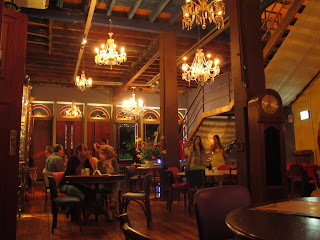 |
| Beautiful decor |
Where best to celebrate my birthday than Rio? After all this is the
place to party. After extensive research on the Internet, we decided to go to
the Rio Scenarium downtown. The neighbourhood is called Lapa and that's where
many of the trendy bars, restaurants and night clubs are. Rio Scenarium opens
at 8pm on Saturdays but when we got there at 7.40pm there was already a queue
of about 50 people to get in!!! Unbelievable. It starts as a nice bar which
also serves food. Then it features live music from 8.30pm to 11pm on the ground
floor while there is a live DJ in the extension. It is huge (3 floors + the
extension) and each section is differently decorated. It is a great place to
spend a birthday.
Archanna and William came that evening and we started getting the
Caipirinias in. We ordered some snacks and caught up on the gossip. Then we
went to the live music and the DJ section. By then the floors were very crowded
with locals and tourists of all ages. It was an excellent night out and we went
back home tipsy and knackered.
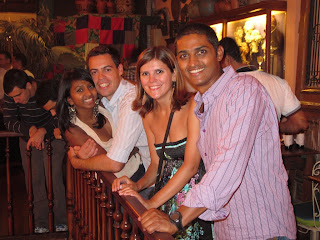 |
| Enjoying the party |
Favela Tour
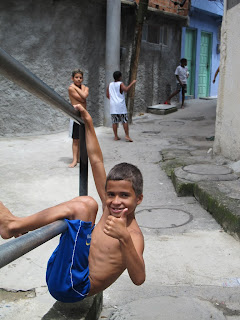 |
| The little kids having fun in the streets |
It always seemed odd to me to actually do a Favela tour. What is the
point of it? To go out there to see some poor people and houses with no running
water nor electricity that were illegally constructed? How dare I do this? But
the truth is that much of what we think about Favelas is only part of the big
picture and there is a lot of stigma associated with favelas. We met this
American guy in our hostel who actually lives in a Favela (recently pacified)
and who said he would bring us there for us to make our own opinion.
We followed him into the favela named Vidigal and took a moto-taxi deep
into the favela. These moto-taxi bring people up and down the huge hill for 2
Reals. When we got there, first thing that catches your eyes is the number of
satellite dishes on roof tops. The main street up the hill was properly built
apparently with the drug barons’ money. We then had a snack in one of the small
eating places and enjoyed an amazing view of Ipanema Bay. The view was amazing.
We also saw some kids with a football and started to play with them. The
youngest of them had great skills and was dribbling and doing all kinds of
tricks with the ball. These Brazilians do live up to their reputation. We were
also explained what a pacified Favela means. Basically the authorities announce
that they are going to come into the favela on a given day to "clean
up". The drugs and arms barons either move out or fight. When the day
comes, the army and police actually moves in with tanks, helicopters, elite
strike forces and take the favela. After that they post a specially trained
police division in the favela to make sure law and order is respected.
The thing is that in all those favela the overwhelming majority are
simple honest hardworkers. But it is true that some of the worst organised
crimes are also run from them. All in all it was an eye opening visit and we
were glad to have done it.
Carnival rehearsal
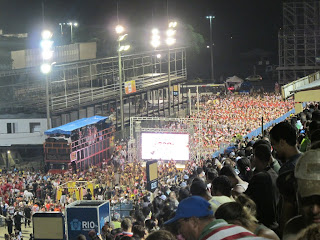 |
| First school getting ready to parade - 800 participants! |
Rio is synonymous with Carnival. And it is a BIG deal here. There are
several dozens of samba schools in Rio preparing all year round for the big
party. These schools are even ranked in divisions and the best ones are
featured in the famous Sambadrome during the carnival. Each school meticulously
rehearse the songs, the choreography and each of their members (up to 800
people parade for each school during carnival) must know all the lyrics and
moves very precisely. In the months leading to the event, the schools hold open
rehearsals where you can dance all night. And as from December, proper
technical rehearsals are held in the Sambadrome for the schools to have a
chance to practise in the venue.
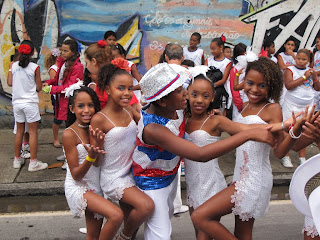 |
| Some of the youngest participants looking their best |
We went to one of those rehearsals and there were 3 schools that
evening: 2 of them from a lower category and the 3rd one from the first
division. The latter school was Salgueiro which is currently 4th in the Samba
school ranking! The Sambadrome can hold up to 90.000 people during the carnival
parades. For the technical rehearsals they open up only one side of the stands
and an average of 35.000 spectators show up. Imagine, 35.000 people attending
the rehearsals only, that's how big a deal it is here.
Even without the full package of chariots and lights the show was great
and people were on fire. We spent the 4 hours there and had a glimpse of what
Carnival in Rio is. We are not going to be there but in Recife for the Carnival
which I'm sure is going to be amazing too.
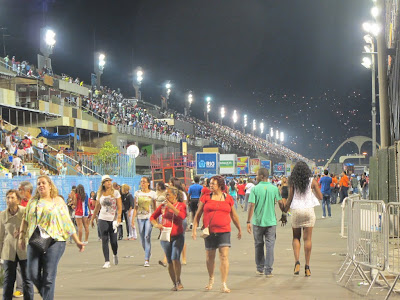 |
| This is how big the Sambadrome is - and this is only one side |
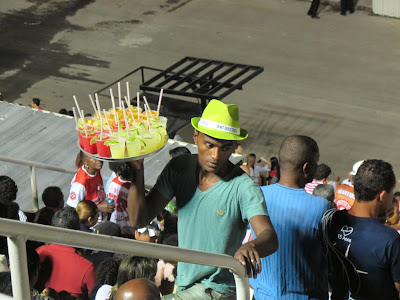 |
| A caipirinha vendor - they look yummie |
Museums (Arte & Cachaca)
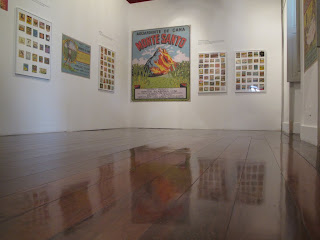 |
| Cachaça labels on show |
The two museums we went two could not be further from one another. The
first one was the museum of modern arts in the city centre while the other one
was the Cachaça museum in the boheme neighbourhood of Santa Teresa.
The latter one was more original for me as they explained the origin of
this sugar cane spirit. I love the Portuguese classification for this type of
drink: Aguardente which literally means Burning Water. They also had a special
work on the different types of labels that have been used over time.
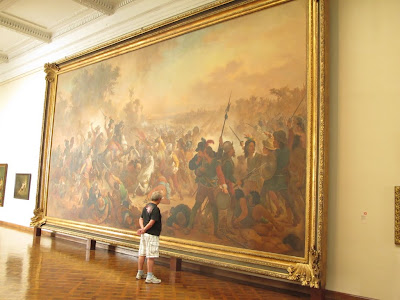 |
| A depiction of an episode of Brazil's history |
Escalera & Santa Teresa
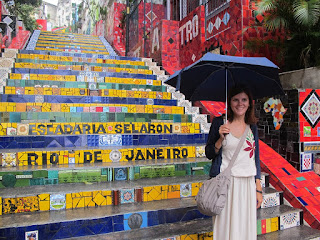 |
| It was a great outing despite the rain |
In that same neighbourhood of Santa Teresa we climbed the superb Selaron stairs. Selaron is a Chilean artist. Those
stairs were amazing and all the ceramics are either made by him or nowadays
sent to him by people all over the world.
He then makes sure that each and every ceramic sent to him is inserted
somewhere in the stairs. He is always replacing older ceramics with new ones
which makes these stairs a perpetually evolving work of art.
Sugar Loaf
 |
| It was impressive especially on a clear day |
The sugar loaf is this superb piece of rock standing in the the bay of
Copacaba. Those of you who are James Bond fans will know that this is the rock
from which Roger Moore glides down in Moonraker pursued by the villain Jaws.
We got up there by taking two cable cars that cost a lot (25€ per
person). That afternoon the sky had cleared up and the view from up there was
spectacular. We could see the whole of Copacabana and its beautiful bay.
Christ redeemer
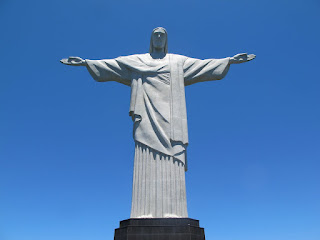 |
| The statue is humbling. |
The 30 metre statue of the Christ is one of the most recognizable
landmarks in the world. It has been voted as one of the 7 new wonders of the
world in 2007. We took the tram up there
which is not as spectacular as people say. It goes through dense vegetation
most of the time which makes it impossible to see anything of the bay. For a
few extra Reals, prefer the car services that bring you up, and you’ll also
avoid the long wait for the two-wagons tramvia.
 |
| The mysterious statue on a cloudy day |
Botanical Garden
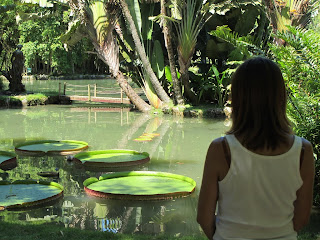 |
| Giant Lily pads |
This botanical garden was a pleasant surprise. It was a welcome break
from the hustle and bustle of the city. Set on 140 hactares this is one of the largest botanical gardens in the world and
one of the most diverse. There are ponds with all kinds of fish and Japanese
gardens, alleys lined with the famous Pau-Brazil tree (from which the country
got its name) and a superb collection of Orchids. There also was a very
interesting section on medicinal plants and their use in traditional medicine.
 |
| The orchids were fascinating |
What we did not do
Maracana Stadium
We could not visit the legendary Maracana stadium which initially could
hold 200.000 spectators and which later was transformed in an 84.000
all-seater. The reason was that extensive works are being done to get it ready
for the 2014 World Cup in Brazil. The Maracana is going to
host the World Cup final game just like in 1950 (Uruguay 2- Brazil 1)
Favela Party
There are favela parties going on during week-ends where daredevils can
go for high adrenaline very dangerous entertainment. Have you seen the shooting
scene when they kill Benny in “City of Gods”? Well we prefered to see this in a
movie!
Boat tour in the bay
We missed the boat tour because unfortunately we did not have enough
time.
Football game and horse racing
Off season – snif!